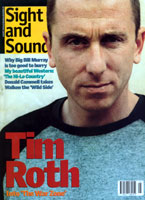Primary navigation

USSR/Cuba 1964
Reviewed by Paul Julian Smith
Our synopses give away the plot in full, including surprise twists.
Four episodes in Cuba, just before the Revolution of 1959. The first begins in a Havana nightclub where prostitutes entertain US tourists. Afro-Cuban bargirl 'Betty' also goes by the name Maria, but her fruit-vendor boyfriend does not know about her job. After a display of orgiastic dancing, Betty's client insists on returning to her shack with her. In the morning he takes her crucifix and faces off her boyfriend, only to be mobbed by hungry children in the slums.
Pedro, an indebted sharecropper, harvests precious sugar cane with his two children. When the landlord arrives and announces he has sold Pedro's farm to the United Fruit Company, Pedro sends his children off into the village and, mad with rage, sets fire to his crops and home.
Back in the city, after burning down a drive-in showing newsreels of the dictator Batista, revolutionary student Enrique saves Gloria, a young woman who is being harassed on the street by US seamen. Enrique defies party discipline and takes aim at a brutal policeman from the top of a skyscraper, but he is unable to pull the trigger. After his companions are shot or arrested for distributing leaflets, Enrique leads an anti-government demonstration at the university. Walking valiantly into the water cannon armed only with a rock, he is shot by the same policeman and receives a hero's burial, attended by Gloria.
The final segment returns to the country. The leader of the revolutionary students in the previous episode, now a bearded guerrilla fighter, seeks support from a poor peasant family. The father replies that his hands are made for sowing not killing. But when the family are bombed out of their farm by government aircraft, the peasant joins the rebels and bravely wins himself a rifle from the enemy. The film ends with the guerrilla army advancing towards Havana and a future of freedom and justice.
Made in 1964, I Am Cuba has been described as Communist kitsch. But from the first shot it is characterised not so much by ideology as by the 'formalism' of which Soviet director Mikhail Kalatozov (Cranes Are Flying, 1957) had been accused in his own country since the 30s. The camera drifts slowly over palm trees mysteriously drained of life by the high-contrast black-and-white photography. A voiceover repeats Russian poet Yevtushenko's portentously poetic script in both Spanish and Russian, while the soundtrack blends Cuban percussion and male voices more suited to the 'Volga Boat Song'. Floating on a canoe in the next shot, we are treated to a repertoire of Kalatozov's techniques which will be obsessively repeated in the next two hours: distorting fish-eye lenses, extreme low and high angles, and a restlessly mobile camera, constantly plunging down into the vegetation or up over the streets and palms.
You can see what worried the Soviet authorities who funded this co-production and sent the crew and equipment to Cuba. Kalatozov clearly aestheticises poverty. The peasant farms of the second and fourth episodes are gardens of Eden, the sugar cane (shot from below once more) a great shining forest stalked by giant peasants. Here the exotic paradise of Cuba gets to play Virgin Nature to the Marxism that promises industrialisation amongst its other benefits. Moreover the camera is clearly consumed by the urban decadence it so stylishly documents. Much of the first episode seems to have drifted in from the David Bailey photo exhibition that was showing at the Barbican during I Am Cuba's run. Bikinied beauties jive atop skyscrapers and the camera even follows them into their rooftop pool to get a closer view. The impossibly glamorous prostitutes, wasp-waisted and beehived, embody a Caribbean cool the revolutionaries, however romantically unkempt, can hardly rival. When Afro-Cuban Betty cuts loose on the dancefloor, the camera gyrates with her, lost in ecstatic but problematic abandon.
It is perhaps not surprising that, according to critic-historian Michael Chanan, such co-productions were not much loved by audiences on the island at the time. But one unexpected pleasure for European viewers today is the glamour of Kalatozov's mise en scène. The film's Havana is not the now-ruinous dereliction of the old city, but a sleek vision of modernity worthy of Wallpaper* magazine. The students drive fast cars along wide highways or scale angular high rises, all concrete, glass and steel. The beachfront Malecón is eerily pristine. Shot just a few years after the Revolution, the film inadvertently reminds us that, in spite of appalling inequality and corruption, Cuba had been more developed than its island neighbours. So the predictable heavy handedness of Kalatozov's propaganda (including the theft of a crucifix by a stereotypically Jewish tourist) is undercut by the uncontrollable aesthetic delight of its visual style. Sugar, intones the voiceover, is sweet; but it is harvested with bitter tears. Entranced with the tropics, Kalatozov swoons over the sweetness and can bring himself only to trudge dutifully through the tears.
This means that in the second, more-didactic half the film falls flat. Political pedagogy, however flashily shot, remains uncinematic; and the anonymous characters (students and peasants but curiously not workers) are too crudely schematic to embody historical process with the dynamic 'typicality' recommended by theorists such as Georg Lukács. But even here inexplicable moments of unmotivated lyricism irrupt: the initially jolly US sailors ("Here come the Navy, hurrah!") seem to be have been drafted in by Busby Berkeley while a snowstorm of revolutionary leaflets spiral down against a darkened sky, a strangely haunting image. If the Revolution's promise of work and freedom now rings unbearably hollow and if the theme of prostitution is uncomfortably relevant today, then I Am Cuba remains, Communist kitsch or not, a memorably eccentric and lyrical hymn to the transformatory powers of cinema.